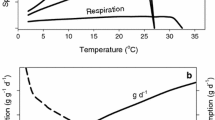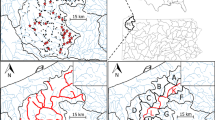Abstract
Climate and dispersal are the two most commonly cited mechanisms to explain spatial synchrony among time series of animal populations, and climate is typically most important for fishes. Using data from 1978–2006, we quantified the spatial synchrony in recruitment and population catch-per-unit-effort (CPUE) for bloater (Coregonus hoyi) populations across lakes Superior, Michigan, and Huron. In this natural field experiment, climate was highly synchronous across lakes but the likelihood of dispersal between lakes differed. When data from all lakes were pooled, modified correlograms revealed spatial synchrony to occur up to 800 km for long-term (data not detrended) trends and up to 600 km for short-term (data detrended by the annual rate of change) trends. This large spatial synchrony more than doubles the scale previously observed in freshwater fish populations, and exceeds the scale found in most marine or estuarine populations. When analyzing the data separately for within- and between-lake pairs, spatial synchrony was always observed within lakes, up to 400 or 600 km. Conversely, between-lake synchrony did not occur among short-term trends, and for long-term trends, the scale of synchrony was highly variable. For recruit CPUE, synchrony occurred up to 600 km between both lakes Michigan and Huron (where dispersal was most likely) and lakes Michigan and Superior (where dispersal was least likely), but failed to occur between lakes Huron and Superior (where dispersal likelihood was intermediate). When considering the scale of putative bloater dispersal and genetic information from previous studies, we concluded that dispersal was likely underlying within-lake synchrony but climate was more likely underlying between-lake synchrony. The broad scale of synchrony in Great Lakes bloater populations increases their probability of extirpation, a timely message for fishery managers given current low levels of bloater abundance.




Similar content being viewed by others
References
Adams JV, Riley SC, Adlerstein SA (2009) Development of fishing power corrections for 12-m Yankee and 21-m wing trawls used in the USGS Lake Huron fall bottom trawl survey. Great Lakes Fish Comm Tech Rep (in press)
Austin JA, Colman SM (2007) Lake Superior summer water temperatures are increasing more rapidly than regional air temperatures: a positive ice-albedo feedback. Geophys Res Lett 34:L06604. doi:10.1029/2006GL029021
Beletsky D, Schwab DJ (2001) Modeling circulation and thermal structure in Lake Michigan: annual cycle and interannual variability. J Geophys Res 106:19745–19771
Bellamy PE, Rothery P, Hinsley SA (2003) Synchrony of woodland bird populations: the effect of landscape structure. Ecography 26:338–348
Blasius B, Huppert A, Stone L (1999) Complex dynamics and phase synchronization in spatially extended ecological systems. Nature 399:354–359
Bunnell DB, Madenjian CP, Croley TE (2006) Long-term trends of bloater recruitment (Coregonus hoyi) in Lake Michigan: evidence for the effect of sex ratio. Can J Fish Aquat Sci 63:832–844
Bunnell DB, David SR, Madenjian CP (2009) Decline in bloater fecundity in southern Lake Michigan after decline of Diporeia. J Great Lakes Res 35:45–49
Cattanéo F, Hugueny B, Lamouroux N (2003) Synchrony in brown trout, Salmo trutta, population dynamics: a ‘Moran effect’ on early-life stages. Oikos 100:43–54
Cheal AJ, Delean S, Sweatman H, Thompson AA (2007) Spatial synchrony in coral reef populations and the influence of climate. Ecology 88:158–169
Christie WJ (1973) A review of the changes in the fish species composition of Lake Ontario. Great Lakes Fish Comm Tech Rep 23
Dettmers JM, Janssen J, Pientka B, Fulford RS, Jude DJ (2005) Evidence across multiple scales for offshore transport of yellow perch (Perca flavescens) larvae in Lake Michigan. Can J Fish Aquat Sci 62:2683–2693
Favé M-J, Turgeon J (2008) Patterns of genetic diversity in Great Lakes bloaters (Coregonus hoyi) with a view to future reintroduction in Lake Ontario. Conserv Genet 9:281–293
Gorman OT, Todd TN, Hoff MH (2007) History of the shortjaw cisco (Coregonus zenithicus) in Lake Superior, 1895–2003. In: Malgorzata J, Brzuzan P, Hliwa P, Luczynski M (eds) Biology and management of coregonid fishes—2005. Advances in Limnology 60. Stuttgart, pp 433–458
Grenfell BT, Wilson K, Finkenstadt BF, Coulson TN, Murray S, Albon SD, Pemberton JM, Clutton-Brock TH, Crawley MJ (1998) Noise and determinism in synchronized sheep dynamics. Nature 394:674–677
Grenouillet G, Hugueny B, Carrel GA, Olivier JM, Pont D (2001) Large-scale synchrony and inter-annual variability in roach recruitment in the Rhone River: the relative role of climatic factors and density-dependent processes. Freshwater Biol 46:11–26
Hanski I, Woiwood IP (1993) Spatial synchrony in the dynamics of moth and aphid populations. J Anim Ecol 62:656–668
Harvey CJ, Kitchell JF (2000) A stable isotope evaluation of the structure and spatial heterogeneity of a Lake Superior food web. Can J Fish Aquat Sci 57:1395–1403
Haydon DT, Greenwood PE (2000) Spatial coupling in cyclic population dynamics: models and data. Theor Popul Biol 58:239–254
Haydon D, Steen H (1997) The effects of large- and small-scale random events on the synchrony of metapopulation dynamics: a theoretical analysis. Proc R Soc Lond B Biol Sci 264:1375–1381
Heino M, Kaitala V, Ranta E, Lindstrom J (1997) Synchronous dynamics and rates of extinction in spatially structured populations. Proc R Soc Lond B Biol Sci 264:481–486
Höök TO, McCormick MJ, Rutherford ES, Mason DM, Carter GS (2006) Short-term water mass movements in Lake Michigan: implications for larval fish transport. J Great Lakes Res 32:728–737
Houde ED (1987) Fish early life dynamics and recruitment variability. Am Fish Soc Symp 2:17–29
Huitu O, Laaksonen J, Norrdahl K, Korpimäki E (2005) Spatial synchrony in vole population fluctuations—a field experiment. Oikos 109:583–593
Ims RA, Steen H (1990) Geographical synchrony in microtine population cycles—a theoretical evaluation of the role of nomadic avian predators. Oikos 57:381–387
Kendall BE, Bjørnstad ON, Bascompte J, Keitt TH, Fagan WF (2000) Dispersal, environmental correlation, and spatial synchrony in population dynamics. Am Nat 155:628–636
Koenig WD (1999) Spatial autocorrelation of ecological phenomena. Trends Ecol Evol 14:22–26
Koenig WD (2002) Global patterns of environmental synchrony and the Moran effect. Ecography 25:283–288
Koenig WD, Knops JMH (1998) Testing for spatial autocorrelation in ecological studies. Ecography 21:423–429
Liebhold A, Koenig WD, Bjørnstad ON (2004) Spatial synchrony in population dynamics. Annu Rev Ecol Evol Syst 35:467–490
Liebhold AM, Johnson DM, Bjørnstad ON (2006) Geographic variation in density-dependent dynamics impacts the synchronizing effect of dispersal and regional stochasticity. Popul Ecol 48:131–138
Lillegård M, Engen S, Sæther B-E (2005) Bootstrap methods for estimating spatial synchrony of fluctuating populations. Oikos 109:342–350
Maceina MJ, Pereira DL (2007) Recruitment. In: Guy CS, Brown ML (eds) Analysis and interpretation of freshwater fisheries data. American Fisheries Society, Bethesda, pp 121–185
Madenjian CP, DeSorcie TJ, Stedman RM (1998) Ontogenic and spatial patterns in diet and growth of lake trout in Lake Michigan. Trans Am Fish Soc 127:236–252
Madenjian CP, Fahnenstiel GL, Johengen TH, Nalepa TF, Vanderploeg HA, Fleischer GW, Schneeberger PJ, Benjamin DM, Smith EB, Bence JR, Rutherford ES, Lavis DS, Robertson DM, Jude DJ, Ebener MP (2002) Dynamics of the Lake Michigan food web, 1970–2000. Can J Fish Aquat Sci 59:736–753
Madenjian CP, Holuszko JD, Desorcie TJ (2006) Spring-summer diet of lake trout on Six Fathom Bank and Yankee Reef in Lake Huron. J Great Lakes Res 32:200–208
Marjomäki TJ, Auvinen H, Helminen H, Huusko A, Sarvala J, Valkeajärvi P, Viljanen M, Karjalainen J (2004) Spatial synchrony in the inter-annual population variation of vendace (Coregonus albula (L.)) in Finnish lakes. Ann Zool Fenn 41:225–240
Miller TJ, Crowder LB, Rice JA, Marschall EA (1988) Larval size and recruitment mechanisms in fishes: toward a conceptual framework. Can J Fish Aquat Sci 45:1657–1670
Moran PAP (1953) The statistical analysis of the Canadian lynx cycle. Aust J Zool 1:291–298
Myers RA, Mertz G, Bridson J (1997) Spatial scale of interannual recruitment variations in marine, anadromous, and freshwater fish. Can J Fish Aquat Sci 54:1400–1407
Oyadomari JK, Auer NA (2008) Transport and growth of larval cisco (Coregonus artedi) in the Keweenaw Current region of Lake Superior. Can J Fish Aquat Sci 65:1447–1458
Paradis E, Baillie SR, Sutherland WJ, Gregory RD (1999) Dispersal and spatial scale affect synchrony in spatial population dynamics. Ecol Lett 2:114–120
Peterson TC, Vose RS (1997) An overview of the Global Historical Climatology Network temperature database. Bull Am Meteorol Soc 78:2837–2849
Phelps QE, Graeb BDS, Willis DW (2008) Influence of the Moran effect on spatiotemporal synchrony in common carp recruitment. Trans Am Fish Soc 137:1701–1708
Ranta E, Kaitala V, Lindström J, Lindén H (1995) Synchrony in population dynamics. Proc R Soc Lond B Biol Sci 262:113–118
Ranta E, Kaitala V, Lundberg P (1998) Population variability in space and time: the dynamics of synchronous population fluctuations. Oikos 83:376–382
Ray BA, Hrabik TR, Ebener MP, Gorman OT, Schreiner DR, Schram ST, Sitar SP, Mattes WP, Bronte CR (2007) Diet and prey selection by Lake Superior lake trout during spring, 1986–2001. J Great Lakes Res 33:104–113
Rice JA, Crowder LB, Holey ME (1987) Exploration of mechanisms regulating larval survival in Lake Michigan bloater: a recruitment analysis based on characteristics of individual larvae. Trans Am Fish Soc 116:703–718
Saylor JH, Sloss PW (1976) Water volume transport and oscillatory current flow through the Straits of Mackinac. J Phys Oceanogr 6:229–237
Schwartz MK, Mills LS, McKelvey KS, Ruggiero LF, Allendorf FW (2002) DNA reveals high dispersal synchronizing the population dynamics of Canada lynx. Nature 415:520–522
Smith SH (1964) Status of the deepwater cisco population of Lake Michigan. Trans Am Fish Soc 93:155–163
Smith OH, Van Oosten J (1940) Tagging experiments with lake trout, whitefish, and other species of fish from Lake Michigan. Trans Am Fish Soc 69:63–84
Tedesco PA, Hugueny B, Paugy D, Fermon Y (2004) Spatial synchrony in population dynamics of West African fishes: a demonstration of an intraspecific and interspecific Moran effect. J Anim Ecol 73:693–705
Ydenberg RC (1987) Nomadic predators and geographical synchrony in microtine population cycles. Oikos 50:270–272
Acknowledgments
We thank T. Desorcie for assistance in estimating distance between sampling sites and developing the figures. We thank S. Delean and M. Drever for assistance with bootstrap coding. We also thank the many biologists, technicians, and vessel crew that have worked to maintain the long-term bottom trawl survey on lakes Superior, Michigan, and Huron. M. Ebener, J. Savino, D. Yule, and several anonymous reviewers provided helpful comments on early manuscript drafts. This article is contribution 1556 of the US Geological Survey Great Lakes Science Center.
Author information
Authors and Affiliations
Corresponding author
Additional information
Communicated by Craig Osenberg.
Electronic supplementary material
Below is the link to the electronic supplementary material.
Rights and permissions
About this article
Cite this article
Bunnell, D.B., Adams, J.V., Gorman, O.T. et al. Population synchrony of a native fish across three Laurentian Great Lakes: evaluating the effects of dispersal and climate. Oecologia 162, 641–651 (2010). https://doi.org/10.1007/s00442-009-1487-6
Received:
Accepted:
Published:
Issue Date:
DOI: https://doi.org/10.1007/s00442-009-1487-6




